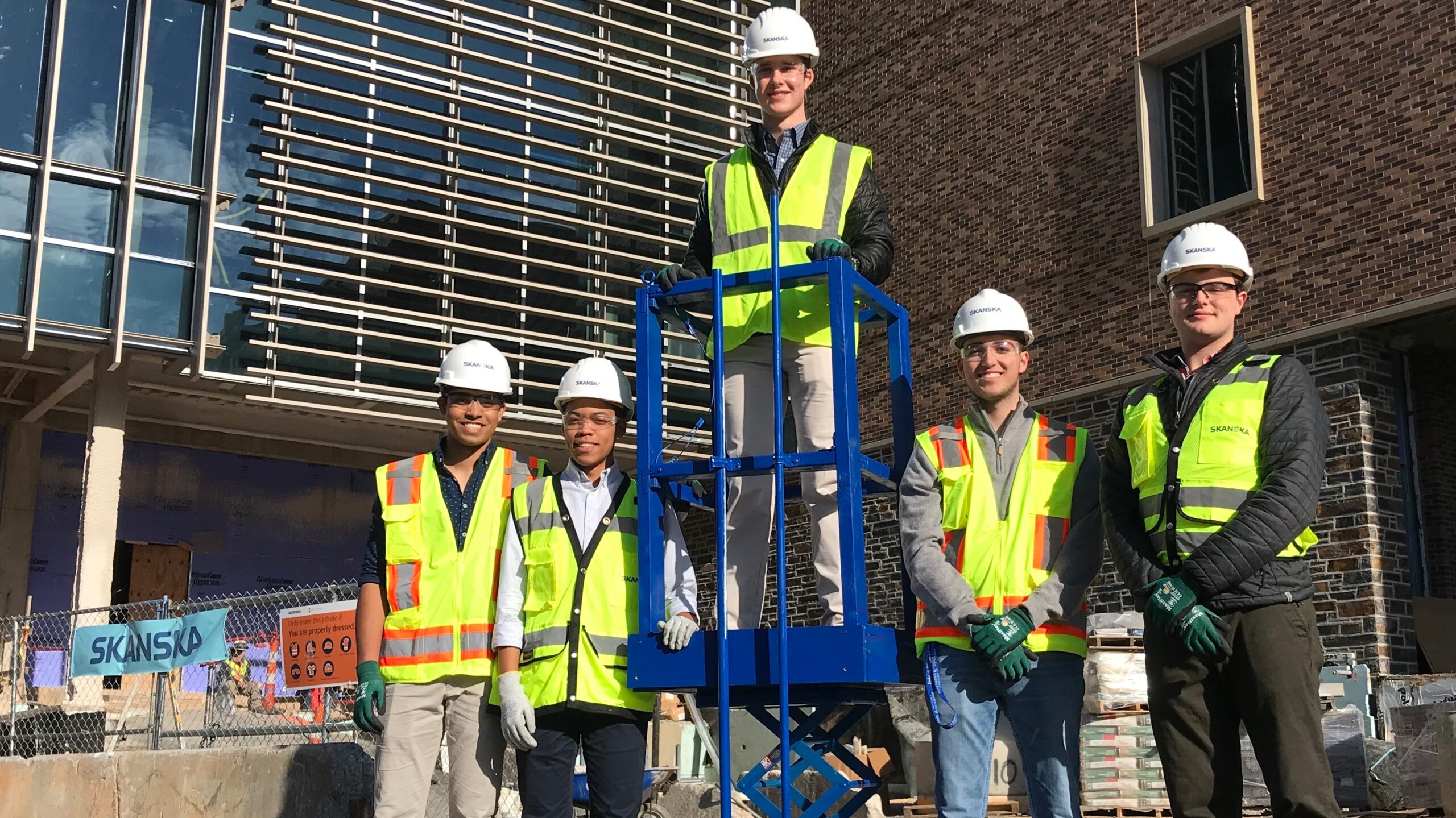Duke First-Year Designers Get a Lift from Skanska
The company constructing Duke’s newest engineering building challenged engineering students to solve a tricky safety problem

After listening, thinking and prototyping, the student design team decided that the heart of their safety-device solution would be a $150 repair lift for dirt bikes.
“We had to modify it significantly,” said design teammate Tevyn Fudge, a first-year Duke Engineering student. “But the jack stand fit all of our criteria.”
The problem they were solving is a significant one and related to a worrying issue of construction worker injuries.
The solution was their culminating project in the innovative EGR 101 course, known as First-Year Design. Taken by all Duke Engineering first-year students, EGR 101 challenges budding engineers to design solutions to authentic problems posed by real-world clients.
For this team, the client was Skanska, the multinational construction company and builder of Duke’s New Engineering Building.
“The timing and placement couldn’t have been more perfect,” said Skanska’s Evan Reilly, an innovation and virtual design and construction (VDC) engineer and 2016 Duke Engineering graduate. “Skanska is always looking for new ideas to improve worker safety and productivity, and the building site was so close to their classroom.”
The problem Skanska engineers brought was the limitations of the scissor lift, a motorized, hydraulic platform used to help workers reach high places. Although often used in place of stationary scaffolding, scissor lifts are not maneuverable enough to reach into congested ceiling spaces, and workers are often tempted to climb safety railings to reach tight spots. Across the country, injuries and deaths from falls have resulted.
At the start of the fall semester, Reilly and Skanska environmental health and safety director Boris Kiprovski pitched the construction safety problem to the class of 350 students. The Skanska team’s presentation stressed the need for innovative thinking to design a new device. It had to provide at least 4 feet of extra reach; be easily set up, portable and durable; and meet company, industry and U.S. government safety regulations.
Fudge and fellow first-year students Michael Wood, Daniel Bolja, Marcus Deans and Nigel Veach accepted the challenge.
“The team built something quite impressive. Each iteration of their idea got better and better.”
Steve McClelland
Executive in Residence and the team’s lead instructor
“We started brainstorming, and just thought about everything that might work, including out-there ideas like magnetic levitation,” Veach said. “Then, we each scored each idea on how likely it was to fit Skanska’s design criteria and our budget.”
An interim design, for which they built a tabletop model, raised a platform with cords and pulleys—but was rejected as potentially hazardous.
Their final solution is a worker-sized platform, with safety railings and ample room for a worker to reach overhead, bolted securely atop the modified motorbike lift. Control rods connect the worker to the lift’s pump-action hydraulic cylinder, which raises and lowers the cage.
“The team built something quite impressive,” said McClelland, the team’s lead instructor. “Each iteration of their idea got better and better.”
Throughout, the students received support and advice from faculty advisors and technical mentors, including Steven McClelland, executive-in-residence for Duke Engineering’s student entrepreneurship programs and himself a Duke Engineering graduate. Also assisting the team were Jennifer West, Fitzpatrick Family University Distinguished Professor of Engineering, Joseph Nadeau, professor of the practice of civil and environmental engineering, and Elizabeth Bucholz, assistant professor of the practice of biomedical engineering.
“I loved being able to be creative in designing a solution and then building it with my own hands. EGR 101 solidified for me that I want to be an engineer.”
Michael Wood
First-year engineering student
The project was scoped by Ann Saterbak, professor of the practice of biomedical engineering and director of the Duke Engineering First-Year Experience.
Throughout EGR 101, students learn to prototype, make presentations and work as a team. Student surveys also suggest the experience boosts confidence, which engineering education researchers term “self-efficacy.”
On a sunny day near the end of the semester, Skanska agreed to let the students put their final prototype on the deck of an actual scissor lift. Outside the Skanska site trailer, the students learned another valuable lesson—precise measurement. It didn’t fit, the bottom plate too wide by only a few eighths of an inch.
“We have learned so much from interacting with experienced engineers,” said Wood, undeterred as he conferred with the team on how to make the device slightly slimmer. “I loved being able to be creative in designing a solution and then building it with my own hands. EGR 101 solidified for me that I want to be an engineer.”
